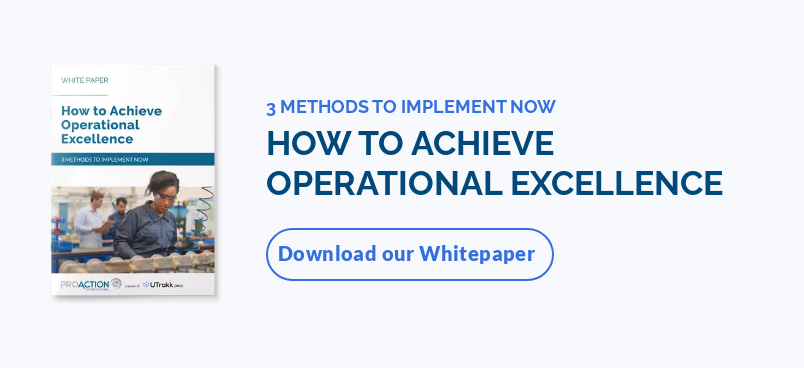What is operational performance?
Operational performance refers to an organization’s ability to efficiently use human, material, financial, and technological resources to achieve its strategic and operational objectives.
It’s based on the management, measurement, and monitoring of performance in SQCDPE areas. Together, these operational performance measures help assess financial efficiency, operational excellence, employee well-being, and environmental responsibility, providing a comprehensive view of an organization’s overall operational performance:
- Safety: Safe work conditions must be in place to prevent accidents and protect employees’ health. In addition to ensuring regulatory compliance, a high level of safety promotes operational stability by reducing interruptions and absenteeism, which has a direct impact on overall operational performance.
- Quality: Product and service quality is based on proactive management of non-conformities and continuous process improvement. Reliable products and services that meet customer expectations strengthen satisfaction and loyalty, two critical aspects for sustainable operational performance.
- Cost: Controlling costs involves optimizing the use of resources while eliminating waste – such as unnecessary time, materials, and energy. Such operational efficiency helps maintain high performance and improve profitability.
- Delivery: Meeting deadlines demonstrates an organization's ability to plan, organize, and respond to the unexpected. Complying with delivery deadlines promotes reliable and responsive service, which is essential for meeting market demands and maintaining customer satisfaction.
- People: A positive work environment where employees feel listened to, recognized, and motivated boosts employee engagement and cohesion. In turn, good employee morale and team dynamics directly contributes to increasing productivity, work quality, and staff retention, three factors that are key to optimal operational performance.
- Environment: Adopting sustainable practices limits the environmental impact of operations by reducing waste, energy consumption, and CO₂ emissions. Beyond regulatory compliance, a proactive environmental approach is part of a responsible and sustainable performance strategy.
Operational performance objectives
Operational performance aims to improve the way an organization creates value by optimizing resource allocation in daily operations. It strives to do better with resources available, without compromising product and service quality and sustainability, through continuous improvement of production processes.
Operational performance objectives, along with other key factors such as corporate culture and leadership quality, form the foundation of a strategy aimed at achieving overall organizational efficiency:
Maximize productivity
Reaching optimal productivity is about getting the best possible return from existing resources – human, material, technological, and financial – without creating overload or waste.
Achieve operational cost savings
Optimizing business processes helps reduce unnecessary expenses, eliminate redundant or non-value-added tasks, and streamline workflows.
Improve the quality of deliverables
Performance is not limited to quantity produced; it’s also measured by the quality of deliverables, i.e., their compliance with customer expectations, internal standards, and the company's service commitments.
Increase responsiveness and flexibility
In an ever-changing environment, it’s essential that teams and systems adapt quickly to unforeseen events, priority changes or new constraints to stay on track with operational performance objectives and maintain competitiveness.
Strengthen process reliability
An organization must rely on proven and stable process improvement methodologies to ensure optimal performance over time.
Key performance indicators (KPIs) to measure operational performance
Management teams must measure operational performance daily to ensure that processes are executed in an optimal way and that the actions taken are generating the desired results.
To do this, it’s essential to rely on key performance indicators (KPIs) that are reliable, accurate, and tailored to the reality of the shop floor and to strategic objectives. These manufacturing KPIs help to assess the results obtained, identify gaps and opportunities for process improvements, and guide better decision-making with tangible, real-time data.
Here are six essential metrics to measure for optimizing operational performance:
- Overall Equipment Effectiveness (OEE) measures the actual equipment performance during its scheduled production time. It combines three key metrics – availability, performance, and quality – providing a comprehensive view of manufacturing productivity.
- The availability rate is the percentage of time a machine or production line operates compared to the scheduled time. It highlights losses related to planned or unplanned downtime, offering valuable insights into reliability and maintenance effectiveness.
- The productivity rate is the quantity produced per unit of time or resource used (labor, machinery, raw material). It directly reflects process efficiency.
- First-Pass Yield (FPY) measures the proportion of compliant products exiting the process without requiring rework or scrap.
- On-Time Delivery (OTD) assesses the percentage of orders delivered on the set date. It influences customer satisfaction and depends on production speed to meet market expectations.
- Mean Time Between Failures (MTBF) measures equipment reliability by calculating the average operating time between two failures. It’s a key indicator for preventing unplanned downtime due to equipment failures, ensuring business continuity, and tracking reliability and maintenance effectiveness over time.
Operational performance measures must always be consistent with set objectives and the situation of each department to target effective actions and support process optimization and improvement.
These metrics can also support the implementation of approaches such as Lean Manufacturing, Six Sigma, or Kaizen, which aim to strengthen business operational performance within a structured framework that ensures sustainability.
8 Steps to efficiently and sustainably improve operational performance

1. Involve frontline teams
Operators, technicians, and frontline managers are at the heart of operational processes: their proximity to production and their experience make them the best people to identify inefficiencies and suggest optimization solutions that will have a real impact.
Involving these key players from the outset is an integral part of a proactive employee engagement culture, which values internal expertise and boosts team motivation.
2. Map processes to identify areas for improvement
Before taking action, it’s important to understand operational processes. Process mapping provides a comprehensive overview of how the organization currently operates: production flows, critical steps, areas of friction, etc.
This analysis highlights downtime, repetitive and/or non-value-added tasks, and helps in identifying priorities and streamlining processes.
3. Define SMART objectives
Once the diagnosis has been made, objectives must be defined in a clear and structured manner to guide impactful actions and facilitate result monitoring. The SMART methodology offers a simple and useful framework for defining objectives:
- Specific: Defined with clarity and precision.
- Measurable: Quantifiable using KPIs to assess progress and success.
- Achievable: Ambitious but achievable with available resources.
- Realistic: Aligned with the company's objectives and strategies.
- Time-bound: Limited to a specific timeframe.
4. Implement solutions to optimize processes
Based on your findings and objectives, implement targeted actions such as reallocating resources, eliminating waste, adjusting workflows, deploying technology integration, or automating tasks.
These initiatives often serve as tests, enabling companies to assess improvements on a small scale before trying a comprehensive transformation of their operations.
5. Measure operational performance regularly
Actions taken must be evaluated using clearly defined key performance indicators. This will enable you to assess the effectiveness of the solutions deployed and quickly identify any discrepancies with the expected results.
6. Monitor results and adjust strategies
Optimizing operational performance is an iterative process. The collected data enables you to reassess choices, correct any discrepancies, and adjust strategies based on the specific circumstances.This ability to adapt is crucial to maintaining performance over time.
7. Leverage the right technology to support operational performance
In addition to management practices such as active supervision tours (or Gemba Walks), digital tools facilitate the planning and management of actions and opportunities, as well as the monitoring of operational performance indicators.
UTrakk is a Daily Management System (DMS) that improves operational performance through powerful features:
- Digital Gemba Walks: Structured and regular field tours ensure that production teams stay on track, KPIs are monitored, and operational performance objectives are achieved.
- Digital checklists: Standardized checklists help monitor critical control points and prioritize tasks aligned with operational performance goals.
- Digitalized management rituals: A meeting management tool supports the creation of structured management rituals, enabling close tracking of actions and KPIs to accelerate performance outcomes.
- Interactive dashboards: Customized dashboards allow for the tracking and analysis of SQCDPE data, enabling fast, informed decision-making to confidently drive operational performance.
By keeping management teams connected to the reality of the shop floor, UTrakk promotes better alignment between daily actions and strategic objectives. This direct link supports continuous improvement and enables optimal operational performance.
8. Standardize and document
When results are positive and new methods are effective, it’s important to document them. Documenting and updating standard operating procedures, operational processes, and work instructions helps to sustain gains, ensure consistency across teams, and facilitate training.
UTrakk’s Knowledge Center promotes the adoption of best practices and the sharing of expertise within an organization. Easily accessible, this digital library allows operations teams to rely on standardized documentation, ensure compliance with standards, and reduce errors to improve performance.
Strategies for sustainable improvement of operational performance
Improving operational performance requires a structured approach that is tailored to the reality of the organization and supported by all stakeholders. To achieve this, many effective strategies can be implemented to build sustainable performance aligned with the company's objectives.
Establish a culture of continuous improvement
Continuous improvement relies on identifying gaps on a daily basis, seeking effective and sustainable solutions, and involving employees in process optimization. By adopting approaches such as PDCA or Kaizen, organizations become more agile, more innovative, and better prepared to adapt to change.
Optimize processes and eliminate waste
Analyzing and streamlining processes reduces wasted time, errors, and unnecessary costs. Lean tools such as Value Stream Mapping (VSM), 5S, and Kanban help visualize areas for improvement and make operations run smoothly.
Measure and track the right KPIs
To drive operational performance, it’s essential to define key performance indicators that are aligned with the organization's strategic and operational objectives. The SQCDPE performance axes provide a balanced framework for tracking results holistically.
Strengthen frontline leadership and communication
Proactive, hands-on management, supported by technology such as UTrakk, helps maintain close ties with operations, quickly identify gaps, and mobilize employees to take action. Regular communication rituals – such as production meetings and continuous improvement committees – promote coordination of priorities and responsiveness to challenges.
Develop team skills and autonomy
Trained, empowered, and autonomous employees are better able to solve problems, take initiative, and contribute ideas for process improvements. Investing in skills development by providing training and development opportunities, and valuing expertise strengthens employee engagement and long-term performance.
Master operational performance through rigorous daily management
Business operational performance cannot be achieved by simply adding up best practices; it emerges from a collective ability to transform intention into action, and action into results. It’s a concrete, demanding discipline that tolerates neither improvisation nor inertia.
A high-performing organization, able to stand out in an increasingly competitive market, knows how to learn from its mistakes, engage all stakeholders, and align daily actions with strategic objectives.
Cultivating this dynamic means choosing to invest in rigor, agility, and transformation. Not as a one-off project, but as a way of working. And that is precisely where operational excellence begins




-1.webp)




